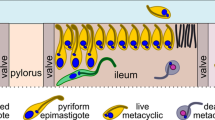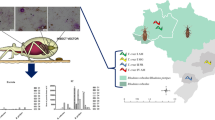Abstract
The first description of an electron microscopic study ofTrypanosoma corvi in the vectorOrnithomyia avicularia is reported. There is a close association between vector and parasite in the midgut, ileum and rectum of the vector. The midgut distribution of parasites is determined by the peritrophic membrane, which confines the early infection to the endoperitrophic space. Parasites escape from the ruptured region of the peritrophic membrane at the pylorus to gain access to the ectoperitrophic space, where intense multiplication occurs. The resulting, smaller epimastigotes attach to the cuticle in the pylorus, ileum and rectum, where they continue multiplying to give rise to mature, short, stumpy trypomastigotes (metacyclics) that are not attached. Attachment to these cuticularly lined regions occurs by the formation of dense, hemidesmosome-like plaques at the extremities of the expanded flagella. A fibrous matrix surrounds the parasites in the ileum. For the first time, intracellular midgut forms are reported forT. corvi inO. avicularia. These parasites enter the cells between the microvilli and penetrate deeply between the folds of the midgut. In the midgut ofO. avicularia, the cells of a mycetome region are packed withRickettsia-like organisms. The significance of these intracellular parasites in the relationship ofT. corvi inO. avicularia remains unknown.
Similar content being viewed by others
References
Baker JR (1956a) Studies onTrypanosoma avium Danilewsky 1885: I. Incidence in some birds of Hertfordshire. Parasitology 46:308–320
Baker JR (1956b) Studies onTrypanosoma avium Danilewsky 1885: II. Transmission byOrnithomyia avicularia. Parasitology 46:321–334
Baker JR (1976) Biology of the trypanosomes of birds. In: Lumsden WHR, Evans DA (eds) Biology of the Kinetoplastida, vol I. Academic Press, London New York San Francisco, pp 131–171
Bennett GF (1961) On the specificity and transmission of some avian trypanosomes. Can J Zool 39:17–33
Bennett GF (1970) Development of trypanosomes of theT. avium complex in the invertebrate host. Can J Zool 48:945–957
Bequaert TC (1953) The Hippoboscidae or louse-flies (Diptera) of mammals and birds. Structure, physiology and natural history. Entomol Am 32:1–209
Cotton TD (1970) A life cycle ofTrypanosoma macfiei, a natural hemoflagellate of canaries (Serinus canarius). J Parasitol 56:63
Desser SS (1977) Ultrastructural observations on the epimastigote stages ofTrypanosoma avium inSimulium rugglesi. Can J Zool 55:1359–1367
Evans DA, Ellis DS (1975) Penetration of mid-gut cells ofGlossina morsitans morsitans byTrypanosoma brucei rhodesiense. Nature 258:231–233
Evans DA, Ellis DS (1978) The penetration ability of sleeping sickness trypanosomes. Trans R Soc Trop Med Hyg 72:653–655
Evans DA, Ellis DS (1983) Recent observations on the behaviour of certain trypanosomes within their insect hosts. Adv Parasitol 22:1–42
Evans DA, Ellis DS, Stamford S (1979) Ultrastructural studies of certain aspects of the development ofTrypanosoma congolense inGlossina m. morsitans. J Protozool 26:557–563
Fairbairn H (1958) The penetration ofTrypanosoma rhodesiense through the peritrophic membrane ofGlossina palpalis. Ann Trop Med Parasitol 52:18–19
Fallis AM, Jacobsen L, Raybould JN (1973) Experimental transmission ofTrypanosoma numidae Wenyon to guinea fowl and chickens in Tanzania. J Protozool 20:436–437
Gordon RM (1957)Trypanosoma congolense in its passage through the peritrophic membrane ofGlossina morsitans Trans R Soc Trop Med Hyg 51:296
Heywood P, Molyneux DH (1985) Ultrastructure of the fibrous matrix surrounding cells ofTrypanosoma melophagium. Cytobios 44:183–188
Hoare CA (1923) An experimental study of the sheep trypanosome (T. melophagium Flu 1908) and its transmission by the sheep ked (Melophagus ovinus L.). Parasitology 15:365–424
Hoare CA (1931a) The peritrophic membrane ofGlossina and its bearing upon the life-cycles ofTrypanosoma grayi. Trans R Soc Trop Med Hyg 25:57–64
Hoare CA (1931b) Studies onTrypanosoma grayi: III. Life-cycle in tsetse-fly and in the crocodile. Parasitology 23:449–484
Hoare CA (1972) The trypanosomes of mammals. A zoological monograph. Blackwell Scientific, Oxford
Kaddu JB, Mutinga MT (1980a)Trypanosoma (Nannomonas) congolense in the basement lamina of the anterior mid-gut cells ofGlossina pallidipes. Acta Trop 37:91–92
Kaddu JB, Mutinga MT (1980b)Trypanosoma (Nannomonas) congolense in the anterior mid-gut cells ofGlossina pallidipes. Ann Trop Med Parasitol 74:255–256
Killick-Kendrick R (1979) Biology ofLeishmania in phleibotomine sandflies. In: Lumsden WHR, Evans DA (eds) Biology of the Kinetoplastida, vol 2. Academic Press, London New York San Francisco, pp 395–460
Lawyer PG, Young DG, Butler JF, Akin DE (1987) Development ofLeishmania mexicana inLutzomyia diabolica andLutzomyia shannoni (Diptera: Psychodidae). J Med Entomol 24:347–355
Macfie JWS, Thomson JG (1929) A trypanosome of the canary (Serinus canarius Koch). Trans R Soc Trop Med Hyg 23:185–191
Maudlin I, Ellis DS (1985) Association between intracellular rickettsia-like infections of mid-gut cells and susceptibility of trypanosome infection inGlossina spp. Z Parasitenkd 71:683–687
Meek SR (1984) Occurrence of rickettsia-like symbionts among species of the scutellaria group (Diptera: Culicidae). Ann Trop Med Parasitol 78:377–381
Minchin EA, Thompson TD (1911) On the occurrence of an intracellular stage in the development ofTrypanosoma lewisi in the rat-flea. Br Med J 361–364
Minchin EA, Thompson TD (1915) The rat trypanosome,Trypanosoma lewisi, in its relation to the rat-flea,Ceratophyllus fasciatus. Q J Microsc Sci 60:463–492
Molyneux DH (1969) Intracellular stages ofTrypanosoma lewisi in fleas and attempts to find such stages in other trypanosome species. Parasitology 59:737–744
Molyneux DH (1975)Trypanosoma (Megatrypanum) melophagium: modes of attachment of parasites to mid-gut, hind-gut and rectum of the sheep ked,Melophagus ovinus. Acta Trop 32:64–73
Molyneux DH (1977a) Vector relationships in the Trypanosomatidae. Adv Parasitol 15:1–82
Molyneux DH (1977b) The attachment ofTrypanosoma grayi in the hind-gut ofGlossina. J Protozool 3:83–86
Molyneux DH (1983) Host-Parasite relationships of Trypanosomatidae in vectors. In: Harris KF (ed) Current Topics in Vector Research, vol 1. Praeger Scientific, New York, pp 117–148
Molyneux DH, Selkirk M, Lavin D (1978)Trypanosoma (Megatrypanum) melophagium in the sheep kedMelophagus ovinus. Acta Trop 35:319–328
Mshelbwala AS (1972)Trypanosoma brucei infection in the haemocoel of tsetse. Trans R Soc Trop Med Hyg 66:637–643
Pollock JN (1971) Origin of the tsetse-flies: a new theory. J Entomol Ser B Taxon 40:101–109
Rodhain J (1942) Au sujet du developpement intracellulaire deTrypanosoma lewisi chezOrnithodorus moubata. Acta Biol Belg 2:416–423
Southwood TRE, Khalaf S, Sinden RE (1975) The micro-or-ganisms of tsetse-flies. Acta Trop 32:259–265
Steinhaus EA (1946) Insect microbiology. Cornstock Public Co. Ltd, Ithaca
Taylor AW (1932) The development of West African strains ofTrypanosoma gambiense inGlossina tachinoides under normal laboratory conditions and at raised temperatures. Parasitology 24:401–418
Theodor OC (1928) Über ein nicht pathogenes Trypanosoma aus der Ziege und seine Übertragung durchLipoptena caprina Aust. Z Parasitenkd 1:283
Wigglesworth VB (1929) Digestion of the tsetse fly. Parasitology 21:288–321
Author information
Authors and Affiliations
Rights and permissions
About this article
Cite this article
Mungomba, L.M., Molyneux, D.H. & Wallbanks, K.R. Host-parasite relationship ofTrypanosoma corvi inOrnithomyia avicularia . Parasitol Res 75, 167–174 (1989). https://doi.org/10.1007/BF00931269
Accepted:
Issue Date:
DOI: https://doi.org/10.1007/BF00931269




